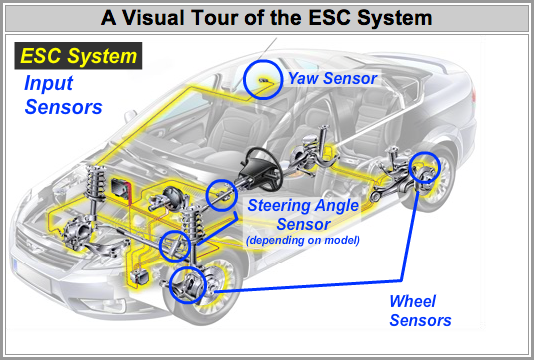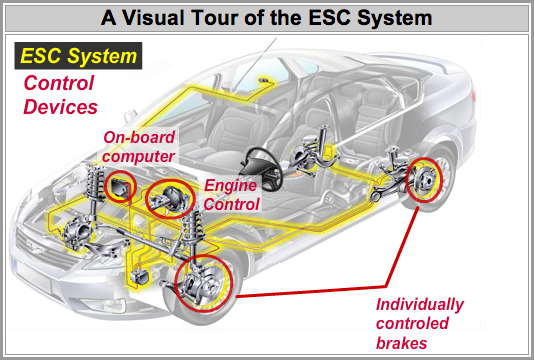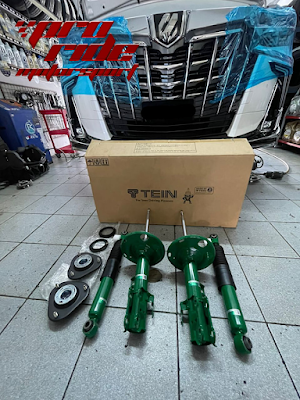CRASH-AVOIDANCE SYSTEMS (ESC)
CRASH-AVOIDANCE SYSTEMS (ESC)
ARE REQUIRED ON ALL NEW CARS, LIGHT TRUCKS, AND SUVS
What is ESC? Imagine a computer system in your vehicle that monitors how the driver is trying to control the vehicle and then takes over in an emergency; like if your tires slip during cornering or if the vehicle is about to spin out or maybe when the steering doesn’t respond quickly enough to avoid
 an obstacle. In an instant, Electronic Stability Control can recognize the problem and take corrective actions: Actions like applying an individual brake to correct steering direction or by reducing engine speed. Provided that the tires have good traction during ESC control, you can safely avoid an accident.
an obstacle. In an instant, Electronic Stability Control can recognize the problem and take corrective actions: Actions like applying an individual brake to correct steering direction or by reducing engine speed. Provided that the tires have good traction during ESC control, you can safely avoid an accident.
ESC is so effective that vehicle accident fatalities were reduced by more than 25% over a five year period. Estimates are that ESC helps avoid 600,000 accidents every year and reduces vehicle roll-overs by 75%. But ESC isn’t new. It was optional equipment in the late 90’s and then grew to being standard equipment on more than 50% of vehicles sold during 2007. ESC and crash avoidance systems actually began with the development of antilock brakes and then traction control. ESC was created by the addition of a Yaw sensor and a computer capable of making more decisions and then sending commands to the brakes and other critical control systems.
Vehicle safety systems continue to improve with additional sensory inputs like proximity sensors and cameras that alert both the driver and the computer. Understanding how your vehicle is equipped and maintaining the vehicle’s traction capabilities (Steering, suspension, shocks, struts, brakes and tires) is critical to the performance of crash avoidance systems.
You can read a full explanation below, or watch this video demonstration from the Discovery Channel.
HOW DOES IT WORK
Electronic Stability Control is designed to slow and control the vehicle from under-steer and over-steer. It uses both ABS and Traction control advantages, along with engine management and a yaw rate sensor to know when the vehicle is going a different direction than the driver intended. This hybrid system helps avoid spin-outs and roll-overs, which in turn, saves lives.
ESC uses the same sensors as ABS and Traction Control, then adds a yaw rate sensor and in some cases a steering angle sensor. This basically results in a computer system that knows the speed of every tire, the intended engine speed, the lean & roll of the vehicle on its axis, the intended steering direction, and when any tire is losing traction. The ESC Computer System is capable of more operational input and can make more rapid driving corrections than any human will ever be capable of.
- Wheel sensors, which monitor speed, direction and rotation.
- Lateral and longitudinal acceleration sensors, which monitors the vehicle’s speed and direction.
- A steering angle sensor, which monitors the driver’s intended direction.
- A yaw sensor, which monitors the vehicle for symptoms of a skid (also known as “spinning out of control”).


Control devices:
ABS, Traction Control, and ESC all control the vehicle by modulating brakes on individual wheels in precise amounts. Unlike the others, ESC also has the ability to modulate the throttle (engine speed) and transmission.
- Individually controlled brakes.
- Throttle (engine speed) control.
- Transmission control (on some models).
ABS works great at preventing skidding and sliding in a straight line, and Traction Control prevents wheel slippage, but only ESC prevents vehicles from skidding during curves.
- ABS (Anti-lock Braking System) is designed to eliminate the tires from locking up or skidding during heavy braking. This helps keep traction and improves maneuverability.
- Traction Control is designed to keep the tires from spinning during acceleration, like on wet or icy conditions. This helps traction during acceleration.



Comments